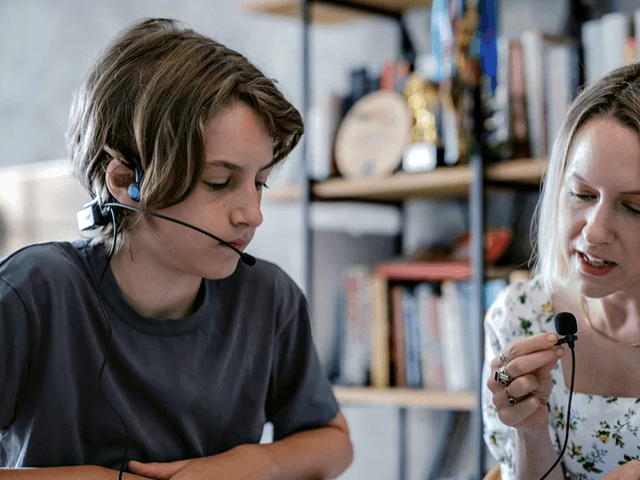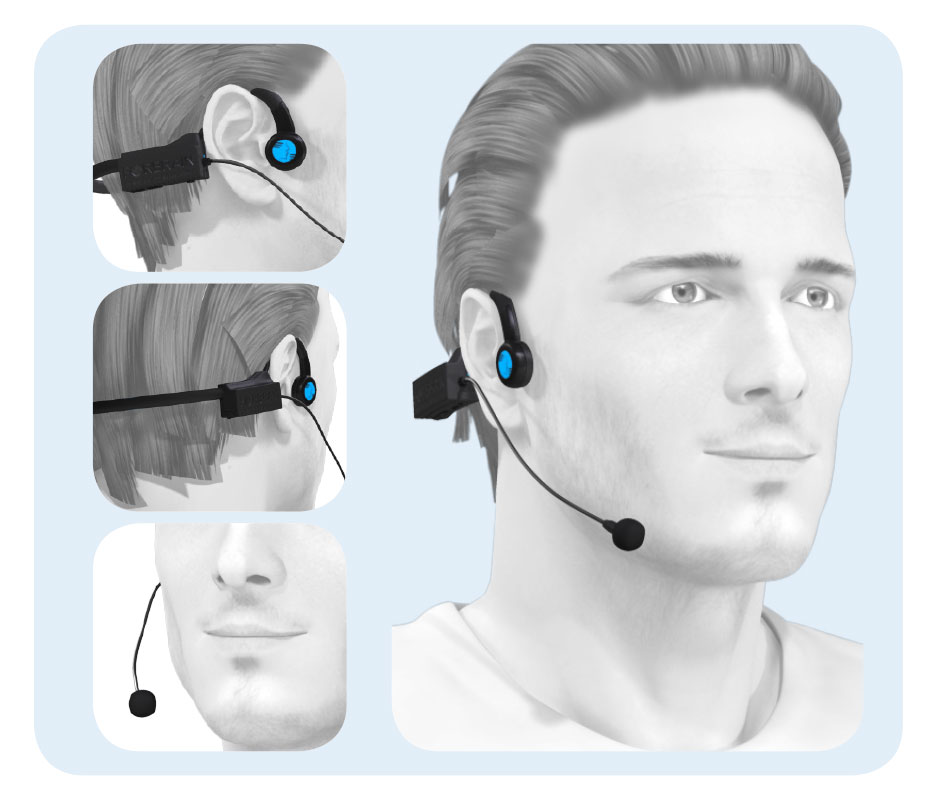


The Forbrain headphones are a device designed to improve speech, attention, memory, and the listening process through auditory stimulation, as used in the Tomatis® method. These headphones utilize bone conduction to transmit the user’s own voice, allowing them to hear it in real-time while speaking into the built-in microphone. This process facilitates more effective learning and helps develop greater speech fluency.
Forbrain is ideal for anyone looking to enhance their cognitive abilities, including those with specific difficulties in listening and verbal fluency. Wearing the headphones and speaking into the built-in microphone helps resolve issues related to poor speech fluency and learning difficulties, making the learning experience more complete and engaging.
If you need other learning products, click here.
Listening through Forbrain is effective due to the modulation of specific sound frequencies critical for proper language development.
The effectiveness of Forbrain learning headphones is based on hearing one’s own voice through bone conduction and specific sound modulation: when the user speaks, the sound captured by the microphone is processed by the patented electronic filter and then transmitted through special transducers positioned on the bones of the temple in front of the ears. This allows the user to instantly hear their own voice clearly and distinctly. The use of Forbrain learning headphones brings benefits to individuals of all ages (children, teenagers, adults, and seniors). Depending on the needs of each individual, targeted exercises can be performed to address specific needs (improving speech fluency, enhancing attention, developing short-term memory, etc.).



Forbrain can be used by different categories of people for various purposes, each of whom can gain specific benefits from its use. Here are some practical examples of typical users and their related benefits:
Benefits: Improvement of reading and learning skills, increased concentration, enhancement of short- and long-term memory, development of language and pronunciation abilities
Examples: Children with reading difficulties (dyslexia), students needing to improve their learning and memorization skills, children with speech disorders
Benefits: Improvement of communication and pronunciation, increased self-confidence during public presentations, reduction of stress and anxiety related to public speaking, enhancement of memory and concentration
Examples: Public speakers, teachers, lawyers, actors, business executives
Benefits: Support for the improvement of cognitive and language skills, stimulation of attention and concentration, assistance in voice and speech control
Examples: Individuals with ADHD (Attention Deficit Hyperactivity Disorder), autism, developmental disabilities
Benefits: Improvement of short- and long-term memory, support in preventing cognitive decline, enhancement of speech clarity and auditory comprehension
Examples: Seniors who want to maintain their mental sharpness, people in the early stages of dementia
Benefits: Enhancement of sound perception and voice modulation, improvement of listening skills and pitch accuracy, assistance in vocal practice and voice control
Examples: Singers, musicians, conductors
Benefits: Improvement of vocal awareness and clarity in expression, enhancement of active listening and emotional self-regulation, support in tone and rhythm control during coaching sessions
Examples: Motivational coaches, sports trainers, corporate trainers, counselors
Thanks to the possibility of connecting an external microphone or an additional audio input, it is possible to listen to any type of external source using the 3.5mm jack cable. This allows you to make the memorization phase even more effective.

Forbrain uses high-frequency vibrations to help users perceive and process sound more effectively. The patented dynamic filter electronically blocks external ambient noise, isolating and amplifying the user’s voice, providing the nervous system with strong sensory training. Additionally, Forbrain headphones enhance long vowels and other critical sounds necessary for proper and effective language development. The resulting sound is produced through bone conduction, rather than the natural air conduction.
The daily use of Forbrain learning headphones enhances your cognitive abilities, attention, memory, speech fluency, and the ability to stay focused. Through bone conduction and the dynamic filter, Forbrain headphones improve sound processing and the transmission of processed sound to the brain. This way, you become less distracted and improve your cognitive efficiency. Maintaining focus allows you to think better and enhance your memory.
The Tomatis® Method is a natural approach to neurosensory stimulation. Its listening programs modify music and voice in real time to capture the brain's attention and develop our motor, emotional, and cognitive skills. Developed by French doctor and researcher Alfred Tomatis, the Tomatis® Method is based on advanced technology and the expertise of professionals specifically trained to use it.
If you need to find a Tomatis® Method specialist, we recommend checking the map available on the official website.
Forbrain learning headphones are designed to work on the audio-vocal loop. They can be used as a complement to active or passive Tomatis® Method sessions. Many professionals, such as vocal coaches, recommend Forbrain headphones to their clients after completing the listening program to maintain the effects of the Tomatis® Method over time. Forbrain learning headphones accelerate learning through regular practice: using the headphones during targeted learning sessions or as recommended by a professional will help you maximize their effectiveness. For children over 3 years old, it is recommended not to exceed 20 minutes of use per day, while for adults, sessions of up to 30 minutes are advised.
If you have any questions or doubts about how Forbrain works,
Click the button below
Forbrain headphones are designed to improve cognitive and sensory abilities through an innovative bone sound transmission system. Here's how they work:
Forbrain headphones are therefore a versatile and innovative tool for improving cognitive and communication skills through auditory stimulation and immediate feedback.
Wearing Forbrain headphones correctly is essential for best results. Here is a step-by-step guide on how to do it:
Now it will be possible to turn on the headphones by pressing the power button (see manual) and start using them.

Forbrain headphones are one size fits all , adapting to offer an excellent fit without the need for specific adjustments. Below we provide some advice for the correct positioning and use of Forbrain :
Forbrain headphones are primarily designed for cognitive and sensory enhancement purposes, using bone transmission technology and a built-in microphone for voice feedback. Here is an overview of the connectivity options offered:
Yes, Forbrain headphones can be useful even if your child does not have a particular problem. Here are some of the benefits you can get from using headphones:
Even if your child doesn't have specific issues, Forbrain headphones can offer numerous benefits. By improving cognitive, language and learning skills, Forbrain can support your child's academic and personal success, making the educational experience more complete and rewarding.
Forbrain headphones are designed to improve various cognitive and language skills. Here are some exercises you can do with Forbrain to maximize the benefits:
To obtain results you need consistency, which is why we recommend starting with 10-15 minute sessions, then moving on to 30 minute sessions, also using it during daily activities. By experimenting with these exercises, you can make the most of Forbrain headphones to improve cognitive and linguistic skills in a fun and engaging way.
The time it takes to see results from using Forbrain may vary depending on several factors, including the frequency and length of sessions, the user's specific cognitive or linguistic needs, and personal commitment. However, here are some general guidelines:
Results from using Forbrain may vary, but with regular and consistent use, many users begin to appreciate improvements within the first few weeks, with more significant benefits emerging after extended use of several months.
Forbrain is simple to use, which is why it is highly appreciated. There is no need for specific exercises or programs to follow on a daily basis, just wear them and continue doing what you have always done; you can talk, sing, read aloud or have conversations while wearing them.
Using the additional microphone is helpful when a parent, therapist, or other training partner can hold the microphone and relay exercise instructions or specific pronunciations. This can help headphone wearers feel comfortable and better process new audio sensations, especially if they are unable to speak or are initially unwilling to speak to Forbrain .
Forbrain and the Tomatis® Method are both tools used to improve cognitive and linguistic skills. Forbrain is supported by the creators of the Tomatis Method and can be used together with this program as Forbrain can be used in everyday activities such as reading and doing homework, which are detailed below.
Forbrain is ideal for those looking for a self-contained, easy-to-use and accessible tool to improve pronunciation, speech fluency and attention through daily exercises.
The Tomatis® Method is most suitable for those who need a highly personalized and supervised approach, which addresses specific cognitive, linguistic or emotional difficulties through intensive and modulated auditory stimulation.
Both tools can be effective, but the choice depends on the user's specific needs, budget and time availability.
Forbrain headphones have gained some recognition among therapists, particularly those who specialize in speech therapy, occupational therapy, and neuropsychology. However, acceptance and use of Forbrain may vary depending on the practitioner and the patient's specific therapeutic needs. Here are some key points to consider:
Forbrain is supported by various scientific studies that attest to its effectiveness in improving cognitive, linguistic and sensory abilities. These studies often show benefits in areas such as memory, attention and verbal fluency.
Many speech pathologists find Forbrain useful as a complementary tool to improve pronunciation, articulation and speech fluency. It is often used in combination with other talk therapy techniques.
Some occupational therapists use Forbrain to improve attention and concentration in their patients, particularly in children with learning disabilities or attention deficits
Forbrain is not specifically approved by all professional therapist associations, but is considered a safe, non-invasive device that can be integrated into individualized treatment plans.
Many therapists share positive testimonials about the effectiveness of Forbrain in their practitioners. These anecdotal reports may vary, but they provide a basis for practical use of the device.
Forbrain is generally seen as a complementary, not a substitute, tool that can be integrated into a broader therapy plan . It can be particularly useful for self-study exercises and daily practice.
It is always advisable to consult a therapist or healthcare professional before starting to use Forbrain , especially if there are specific therapeutic needs or medical conditions. The effectiveness of Forbrain may vary from person to person, and therapist feedback may depend on individual observations and specific patient needs.
Forbrain and Soundsory are both tools designed to improve cognitive and sensory skills through the use of music and sound, but they use different approaches and technologies. Here's a comparison between the two:
Forbrain is simpler and more accessible, ideal for self-study exercises and daily language practices at home. - ** Soundsory ** is more structured and complete, with a combination of sound and motor stimuli guided by a professional to improve different cognitive and sensory skills.
Soundsory is more structured and complete, with a combination of sound and motor stimuli guided by a professional to improve various cognitive and sensory skills.
The choice between the two depends on individual needs , personal preferences and availability of resources, with Forbrain may be more suitable for those looking for a stand-alone and convenient solution , while Soundsory may be preferred for those looking for a more complete and personalized program below the guidance of a professional.
Forbrain is the only tool available to use a dynamic filter and bone conduction. The patented filter opens and closes in response to certain sounds, then transmits sound waves to the wearer via bone conduction while the ear remains free. The technology is unique and integrates perfectly with other therapies.